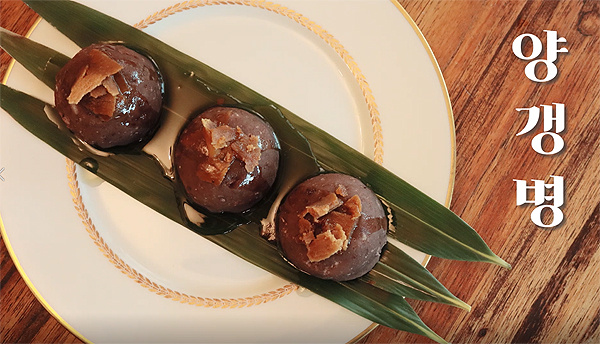Yanggaengbyeong: Chewy Traditional Korean Dessert Made with Red Beans
Yanggaengbyeong: A Classic Korean Confectionery Recipe Featuring the Rich Flavor of Red Beans

Introducing a simple recipe for Yanggaengbyeong, a traditional Korean dessert, that you can make at home. This delightful treat boasts the deep flavor of red beans and a wonderfully chewy texture, making it a perfect sweet snack, especially for those who enjoy Tteok (rice cakes) and Hangwa (Korean traditional confectionery). Inspired by a cookbook, this Yanggaengbyeong recipe details the process of boiling and pureeing red beans to create a smooth paste, adding a subtly sweet syrup, and achieving that characteristic chewy consistency.
Ingredients for Yanggaengbyeong- 300g red beans
- 200g sugar
- 200g water
- 75g flour
Cooking Instructions
Step 1
First, let’s make the syrup that will determine the sweetness of your Yanggaengbyeong. In a pot, combine 200g of sugar and 200g of water in a 1:1 ratio. Over low heat, slowly stir until the sugar dissolves. Once it starts dissolving, stop stirring and let it simmer gently until the water reduces and thickens into a syrup. Avoid stirring once the sugar dissolves to prevent crystallization.

Step 2
While the syrup is being made, let’s prepare the red beans. Rinse 300g of red beans thoroughly and place them in a pot with plenty of water. Boil them until they are very soft and cooked through. Think of Yanggaengbyeong as a steamed red bean jelly; this will help you understand the process better. It’s crucial to boil the beans until they are tender enough to mash easily.

Step 3
The core and most labor-intensive step in making Yanggaengbyeong is pureeing the cooked red beans. Place the boiled red beans in a sieve. Using the back of a spoon or a spatula, press down to gently mash the beans, allowing only the smooth, soft interior to pass through the sieve. With about 15 minutes of focused effort, you’ll achieve a fine red bean paste.

Step 4
Separate the husks (skins) from the smooth red bean paste that you’ve sieved. Collect the soft, fine paste; this paste itself is incredibly delicious and has a melt-in-your-mouth texture that is simply exquisite. It’s so good, you could eat it as is!

Step 5
To the prepared red bean paste, add 75g of flour and mix well until evenly combined. Then, incorporate about 4 tablespoons of the syrup you made earlier. Knead the mixture until it becomes a chewy, cohesive dough. When you can form a sticky ball that holds its shape, your base dough for Yanggaengbyeong is ready. If you have molds, shape the dough in them. Otherwise, you can press it into small bowls lined with parchment paper to form shapes.

Step 6
Place the shaped red bean dough into a steamer. Once the water is boiling and steam is rising, steam the Yanggaengbyeong. Make sure to check the water level in the steamer periodically to prevent it from running dry.

Step 7
Steam for a total of 20 minutes, then turn off the heat and let it steep for another 5 minutes. Your delicious traditional Yanggaengbyeong is now complete! Drizzle any remaining syrup over the freshly steamed dessert to your liking. For an elegant touch, garnish with palm sugar instead of rock sugar. If you have rock sugar, it will give a more traditional appearance.

Step 8
In this recipe, we used palm sugar for garnish as rock sugar was unavailable, but using rock sugar would add a more traditional aesthetic. If you don’t have either rock sugar or palm sugar, finely chopped nuts (like walnuts or pine nuts) sprinkled on top would also make a delicious garnish and add a pleasant crunch. Feel free to adapt it to your preference.

Step 9
As a helpful tip, if you line your steaming container with bamboo leaves or place a piece of bamboo inside, it’s said to help slow down the staling process, allowing your Yanggaengbyeong to stay fresh for longer. Incorporate this traditional storage tip!



